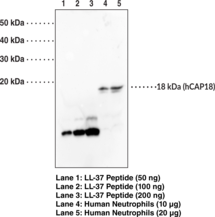Cayman
Showing 27751–27900 of 45550 results
-
Lipoxin B4 (LXB4) methyl ester is a lipid soluble prodrug form of the transcellular metabolite LXB4 (Item No. 90420). LXB4 is a positional isomer of LXA4 (Item No. 90410) produced by the metabolism of 15-HETE (Item No. 34700) or 15-HpETE (Item No. 44720) by human leukocytes.{369,350} At a concentration of 100 nM, LXB4 inhibits polymorphonuclear leukocyte (PMN) migration stimulated by leukotriene B4 (LTB4; Item No. 20110) and inhibits LTB4-induced adhesion of PMNs with an IC50 value of 0.3 nM.{16457}
Brand:CaymanSKU:24073 - 100 µgAvailable on backorder
Lipoxin B4 (LXB4) methyl ester is a lipid soluble prodrug form of the transcellular metabolite LXB4 (Item No. 90420). LXB4 is a positional isomer of LXA4 (Item No. 90410) produced by the metabolism of 15-HETE (Item No. 34700) or 15-HpETE (Item No. 44720) by human leukocytes.{369,350} At a concentration of 100 nM, LXB4 inhibits polymorphonuclear leukocyte (PMN) migration stimulated by leukotriene B4 (LTB4; Item No. 20110) and inhibits LTB4-induced adhesion of PMNs with an IC50 value of 0.3 nM.{16457}
Brand:CaymanSKU:24073 - 25 µgAvailable on backorder
Lipoxin B4 (LXB4) methyl ester is a lipid soluble prodrug form of the transcellular metabolite LXB4 (Item No. 90420). LXB4 is a positional isomer of LXA4 (Item No. 90410) produced by the metabolism of 15-HETE (Item No. 34700) or 15-HpETE (Item No. 44720) by human leukocytes.{369,350} At a concentration of 100 nM, LXB4 inhibits polymorphonuclear leukocyte (PMN) migration stimulated by leukotriene B4 (LTB4; Item No. 20110) and inhibits LTB4-induced adhesion of PMNs with an IC50 value of 0.3 nM.{16457}
Brand:CaymanSKU:24073 - 50 µgAvailable on backorder
Brand:CaymanSKU:760710 - 1 eaAvailable on backorder
Lipoxygenases are members of a class of non-heme iron-containing dioxygenases that catalyze the addition of molecular oxygen to fatty acids containing a cis,cis-1,4-pentadiene system to give an unsaturated fatty acid hydroperoxide. In mammals, lipoxygenases carry out the first step in the arachidonic acid cascade.{3140,2972} 5- and 15-LOs lead to the biologically active lipoxins, whereas 5-LO leads to 5,6-epoxy-leukotrienes which are involved in a variety of inflammatory responses, including neutrophil chemotaxis, vascular permeability, and smooth muscle contraction.{482} In contrast, Nassar, et al., suggested that animal 15-LO products act as anti-inflammatory agents.{1390} This implies that the 5- and 15-LO pathways may play a role in regulating inflammation. To elucidate the role of each lipoxygenase, it is particularly important to develop inhibitors that are enzyme specific. This assay kit provides an accurate and convenient method for screening lipoxygenase inhibitors. This assay measures the hydroperoxides generated from the incubation of a lipoxygenase (5-, 12-, or 15-LO) with either arachidonic or linoleic acid.
Brand:CaymanSKU:760700 - 96 wellsAvailable on backorder
Lipoxygenin is an inhibitor of 5-lipoxygenase (5-LO) with an IC50 value of 5 µM for inhibition of 5-LO product synthesis in isolated human granulocytes stimulated with the cation ionophore A23187 (Item No. 22030).{48965} It inhibits hedgehog-dependent signaling in Shh-LIGHT2 cells and TGF-β-, activin A-, bone morphogenic protein (BMP)-, or Wnt-dependent signaling in HEK293T cells (IC50s = 9.3, 3.2, 8.2, 9.6, and 3.7 µM, respectively, in luciferase reporter assays). Lipoxygenin (5 and 10 µM) increases levels of troponin T (TnnT), a marker of cardiomyocyte differentiation, in human induced pluripotent stem cells (iPSCs) stimulated with BMP4 and the glycogen synthase kinase 3 (GSK3) inhibitor CHIR99021 (Item No. 13122).
Brand:CaymanSKU:26310 - 1 mgAvailable on backorder
Lipoxygenin is an inhibitor of 5-lipoxygenase (5-LO) with an IC50 value of 5 µM for inhibition of 5-LO product synthesis in isolated human granulocytes stimulated with the cation ionophore A23187 (Item No. 22030).{48965} It inhibits hedgehog-dependent signaling in Shh-LIGHT2 cells and TGF-β-, activin A-, bone morphogenic protein (BMP)-, or Wnt-dependent signaling in HEK293T cells (IC50s = 9.3, 3.2, 8.2, 9.6, and 3.7 µM, respectively, in luciferase reporter assays). Lipoxygenin (5 and 10 µM) increases levels of troponin T (TnnT), a marker of cardiomyocyte differentiation, in human induced pluripotent stem cells (iPSCs) stimulated with BMP4 and the glycogen synthase kinase 3 (GSK3) inhibitor CHIR99021 (Item No. 13122).
Brand:CaymanSKU:26310 - 10 mgAvailable on backorder
Lipoxygenin is an inhibitor of 5-lipoxygenase (5-LO) with an IC50 value of 5 µM for inhibition of 5-LO product synthesis in isolated human granulocytes stimulated with the cation ionophore A23187 (Item No. 22030).{48965} It inhibits hedgehog-dependent signaling in Shh-LIGHT2 cells and TGF-β-, activin A-, bone morphogenic protein (BMP)-, or Wnt-dependent signaling in HEK293T cells (IC50s = 9.3, 3.2, 8.2, 9.6, and 3.7 µM, respectively, in luciferase reporter assays). Lipoxygenin (5 and 10 µM) increases levels of troponin T (TnnT), a marker of cardiomyocyte differentiation, in human induced pluripotent stem cells (iPSCs) stimulated with BMP4 and the glycogen synthase kinase 3 (GSK3) inhibitor CHIR99021 (Item No. 13122).
Brand:CaymanSKU:26310 - 5 mgAvailable on backorder
Liproxstatin-1 is a ferroptosis inhibitor.{28622} It inhibits ferroptotic cell death (IC50 = 22 nM) and lipid peroxidation in mouse embryonic fibroblasts (MEFs) with an inducible knockdown of glutathione peroxidase 4 (Gpx4-/- MEFs) when used at a concentration of 50 nM. Liproxstatin-1 also inhibits ferroptosis induced by the ferroptosis-inducing agents L-buthionine sulphoximine (BSO), erastin (Item No. 17754), and (1S,3R)-RSL3 (Item No. 19288) in a concentration-dependent manner in MEFs, but does not inhibit necroptosis, apoptosis, or necrosis. It inhibits cell death and lipid peroxidation induced by (1S,3R)-RSL3 in human renal proximal tubule epithelial cells. Liproxstatin-1 (10 mg/kg) increases survival and decreases TUNEL+ kidney cells in inducible Gpx4-/- mice and reduces tissue injury in a mouse model of hepatic ischemia/reperfusion injury. It is also an antioxidant that inhibits autooxidation of lipids by trapping peroxyl radicals.{43395}
Brand:CaymanSKU:-Available on backorder
Liproxstatin-1 is a ferroptosis inhibitor.{28622} It inhibits ferroptotic cell death (IC50 = 22 nM) and lipid peroxidation in mouse embryonic fibroblasts (MEFs) with an inducible knockdown of glutathione peroxidase 4 (Gpx4-/- MEFs) when used at a concentration of 50 nM. Liproxstatin-1 also inhibits ferroptosis induced by the ferroptosis-inducing agents L-buthionine sulphoximine (BSO), erastin (Item No. 17754), and (1S,3R)-RSL3 (Item No. 19288) in a concentration-dependent manner in MEFs, but does not inhibit necroptosis, apoptosis, or necrosis. It inhibits cell death and lipid peroxidation induced by (1S,3R)-RSL3 in human renal proximal tubule epithelial cells. Liproxstatin-1 (10 mg/kg) increases survival and decreases TUNEL+ kidney cells in inducible Gpx4-/- mice and reduces tissue injury in a mouse model of hepatic ischemia/reperfusion injury. It is also an antioxidant that inhibits autooxidation of lipids by trapping peroxyl radicals.{43395}
Brand:CaymanSKU:-Available on backorder
Liproxstatin-1 is a ferroptosis inhibitor.{28622} It inhibits ferroptotic cell death (IC50 = 22 nM) and lipid peroxidation in mouse embryonic fibroblasts (MEFs) with an inducible knockdown of glutathione peroxidase 4 (Gpx4-/- MEFs) when used at a concentration of 50 nM. Liproxstatin-1 also inhibits ferroptosis induced by the ferroptosis-inducing agents L-buthionine sulphoximine (BSO), erastin (Item No. 17754), and (1S,3R)-RSL3 (Item No. 19288) in a concentration-dependent manner in MEFs, but does not inhibit necroptosis, apoptosis, or necrosis. It inhibits cell death and lipid peroxidation induced by (1S,3R)-RSL3 in human renal proximal tubule epithelial cells. Liproxstatin-1 (10 mg/kg) increases survival and decreases TUNEL+ kidney cells in inducible Gpx4-/- mice and reduces tissue injury in a mouse model of hepatic ischemia/reperfusion injury. It is also an antioxidant that inhibits autooxidation of lipids by trapping peroxyl radicals.{43395}
Brand:CaymanSKU:-Available on backorder
Liproxstatin-1 is a ferroptosis inhibitor.{28622} It inhibits ferroptotic cell death (IC50 = 22 nM) and lipid peroxidation in mouse embryonic fibroblasts (MEFs) with an inducible knockdown of glutathione peroxidase 4 (Gpx4-/- MEFs) when used at a concentration of 50 nM. Liproxstatin-1 also inhibits ferroptosis induced by the ferroptosis-inducing agents L-buthionine sulphoximine (BSO), erastin (Item No. 17754), and (1S,3R)-RSL3 (Item No. 19288) in a concentration-dependent manner in MEFs, but does not inhibit necroptosis, apoptosis, or necrosis. It inhibits cell death and lipid peroxidation induced by (1S,3R)-RSL3 in human renal proximal tubule epithelial cells. Liproxstatin-1 (10 mg/kg) increases survival and decreases TUNEL+ kidney cells in inducible Gpx4-/- mice and reduces tissue injury in a mouse model of hepatic ischemia/reperfusion injury. It is also an antioxidant that inhibits autooxidation of lipids by trapping peroxyl radicals.{43395}
Brand:CaymanSKU:-Available on backorder
Brand:CaymanSKU:28591 - 1 mgAvailable on backorder
Brand:CaymanSKU:28591 - 10 mgAvailable on backorder
Brand:CaymanSKU:28591 - 5 mgAvailable on backorder
Liquiritin is a flavonoid that has been found in Glycyrrhiza and has diverse biological activities.{53639,53640,53641} It inhibits corticosterone-induced apoptosis in PC12 cells when used at concentrations of 1 and 2 mg/ml.{53639} Liquiritin (120 mg/kg) reduces spinal cord levels of IL-1β, IL-6, and TNF-α and alleviates mechanical and cold allodynia, as well as thermal hyperalgesia, in a mouse model of neuropathic pain induced by chronic constriction injury (CCI) of the sciatic nerve.{53640} It decreases the viability of SiHa, CaSki, and HeLa cervical cancer cells and inhibits migration and invasion of SiHa cells in vitro when used at concentrations of 40, 60, and 80 μM.{53641} Liquiritin (10, 20, and 30 mg/kg) reduces tumor growth in a SiHa mouse xenograft model.
Brand:CaymanSKU:30263 - 10 mgAvailable on backorder
Liquiritin is a flavonoid that has been found in Glycyrrhiza and has diverse biological activities.{53639,53640,53641} It inhibits corticosterone-induced apoptosis in PC12 cells when used at concentrations of 1 and 2 mg/ml.{53639} Liquiritin (120 mg/kg) reduces spinal cord levels of IL-1β, IL-6, and TNF-α and alleviates mechanical and cold allodynia, as well as thermal hyperalgesia, in a mouse model of neuropathic pain induced by chronic constriction injury (CCI) of the sciatic nerve.{53640} It decreases the viability of SiHa, CaSki, and HeLa cervical cancer cells and inhibits migration and invasion of SiHa cells in vitro when used at concentrations of 40, 60, and 80 μM.{53641} Liquiritin (10, 20, and 30 mg/kg) reduces tumor growth in a SiHa mouse xenograft model.
Brand:CaymanSKU:30263 - 25 mgAvailable on backorder
Liquiritin is a flavonoid that has been found in Glycyrrhiza and has diverse biological activities.{53639,53640,53641} It inhibits corticosterone-induced apoptosis in PC12 cells when used at concentrations of 1 and 2 mg/ml.{53639} Liquiritin (120 mg/kg) reduces spinal cord levels of IL-1β, IL-6, and TNF-α and alleviates mechanical and cold allodynia, as well as thermal hyperalgesia, in a mouse model of neuropathic pain induced by chronic constriction injury (CCI) of the sciatic nerve.{53640} It decreases the viability of SiHa, CaSki, and HeLa cervical cancer cells and inhibits migration and invasion of SiHa cells in vitro when used at concentrations of 40, 60, and 80 μM.{53641} Liquiritin (10, 20, and 30 mg/kg) reduces tumor growth in a SiHa mouse xenograft model.
Brand:CaymanSKU:30263 - 5 mgAvailable on backorder
Liquiritin is a flavonoid that has been found in Glycyrrhiza and has diverse biological activities.{53639,53640,53641} It inhibits corticosterone-induced apoptosis in PC12 cells when used at concentrations of 1 and 2 mg/ml.{53639} Liquiritin (120 mg/kg) reduces spinal cord levels of IL-1β, IL-6, and TNF-α and alleviates mechanical and cold allodynia, as well as thermal hyperalgesia, in a mouse model of neuropathic pain induced by chronic constriction injury (CCI) of the sciatic nerve.{53640} It decreases the viability of SiHa, CaSki, and HeLa cervical cancer cells and inhibits migration and invasion of SiHa cells in vitro when used at concentrations of 40, 60, and 80 μM.{53641} Liquiritin (10, 20, and 30 mg/kg) reduces tumor growth in a SiHa mouse xenograft model.
Brand:CaymanSKU:30263 - 50 mgAvailable on backorder
Liraglutide is a potent agonist of the glucagon-like peptide 1 (GLP-1) receptor and a synthetic derivative of GLP-1 (7-37) (Item No. 24887) that contains a palmitic acid group.{43159} It increases cAMP accumulation in CHO cells expressing the human GLP-1 receptor (EC50 = 61 pM). Liraglutide (100-1,000 nM) inhibits cytokine- and free fatty acid-induced apoptosis of primary neonatal rat pancreatic β-cells in vitro by greater than 95 and 50%, respectively, effects that are blocked by the GLP-1 receptor antagonist exendin-3 (9-39) (Item No. 19890) and the PI3 kinase inhibitor wortmannin (Item No. 10010591).{43160} In a rat model of obesity induced by supplemental dietary candy, liraglutide (0.2 mg/kg, s.c., twice per day) decreases calorie intake, shifts food preference to a higher ratio of chow to candy, reverses weight and fat gains, and increases insulin sensitivity.{43161} Formulations containing liraglutide have been used as adjuncts in the treatment of type 2 diabetes and for chronic weight management in overweight or obese adults.
Brand:CaymanSKU:24727 - 1 mgAvailable on backorder
Liraglutide is a potent agonist of the glucagon-like peptide 1 (GLP-1) receptor and a synthetic derivative of GLP-1 (7-37) (Item No. 24887) that contains a palmitic acid group.{43159} It increases cAMP accumulation in CHO cells expressing the human GLP-1 receptor (EC50 = 61 pM). Liraglutide (100-1,000 nM) inhibits cytokine- and free fatty acid-induced apoptosis of primary neonatal rat pancreatic β-cells in vitro by greater than 95 and 50%, respectively, effects that are blocked by the GLP-1 receptor antagonist exendin-3 (9-39) (Item No. 19890) and the PI3 kinase inhibitor wortmannin (Item No. 10010591).{43160} In a rat model of obesity induced by supplemental dietary candy, liraglutide (0.2 mg/kg, s.c., twice per day) decreases calorie intake, shifts food preference to a higher ratio of chow to candy, reverses weight and fat gains, and increases insulin sensitivity.{43161} Formulations containing liraglutide have been used as adjuncts in the treatment of type 2 diabetes and for chronic weight management in overweight or obese adults.
Brand:CaymanSKU:24727 - 5 mgAvailable on backorder
Liraglutide is a potent agonist of the glucagon-like peptide 1 (GLP-1) receptor and a synthetic derivative of GLP-1 (7-37) (Item No. 24887) that contains a palmitic acid group.{43159} It increases cAMP accumulation in CHO cells expressing the human GLP-1 receptor (EC50 = 61 pM). Liraglutide (100-1,000 nM) inhibits cytokine- and free fatty acid-induced apoptosis of primary neonatal rat pancreatic β-cells in vitro by greater than 95 and 50%, respectively, effects that are blocked by the GLP-1 receptor antagonist exendin-3 (9-39) (Item No. 19890) and the PI3 kinase inhibitor wortmannin (Item No. 10010591).{43160} In a rat model of obesity induced by supplemental dietary candy, liraglutide (0.2 mg/kg, s.c., twice per day) decreases calorie intake, shifts food preference to a higher ratio of chow to candy, reverses weight and fat gains, and increases insulin sensitivity.{43161} Formulations containing liraglutide have been used as adjuncts in the treatment of type 2 diabetes and for chronic weight management in overweight or obese adults.
Brand:CaymanSKU:24727 - 500 µgAvailable on backorder
Lisinopril is an angiotensin-converting enzyme (ACE) inhibitor (IC50 = 1.2 nM).{16807} It reduces the formation of endothelin-1 (Item No. 24127) and increases nitric oxide (NO) in human vascular endothelial cells when used at a concentration of 0.1 nM.{16847} Lisinopril inhibits the pressor response to angiotensin I in anesthetized rats and dogs (ID50s = 2.3 and 6.5 µg/kg, respectively).{16807}
Brand:CaymanSKU:-Out of stock
Lisinopril is an angiotensin-converting enzyme (ACE) inhibitor (IC50 = 1.2 nM).{16807} It reduces the formation of endothelin-1 (Item No. 24127) and increases nitric oxide (NO) in human vascular endothelial cells when used at a concentration of 0.1 nM.{16847} Lisinopril inhibits the pressor response to angiotensin I in anesthetized rats and dogs (ID50s = 2.3 and 6.5 µg/kg, respectively).{16807}
Brand:CaymanSKU:-Out of stock
Lisinopril is an angiotensin-converting enzyme (ACE) inhibitor (IC50 = 1.2 nM).{16807} It reduces the formation of endothelin-1 (Item No. 24127) and increases nitric oxide (NO) in human vascular endothelial cells when used at a concentration of 0.1 nM.{16847} Lisinopril inhibits the pressor response to angiotensin I in anesthetized rats and dogs (ID50s = 2.3 and 6.5 µg/kg, respectively).{16807}
Brand:CaymanSKU:-Out of stock
Lisinopril is an angiotensin-converting enzyme (ACE) inhibitor (IC50 = 1.2 nM).{16807} It reduces the formation of endothelin-1 (Item No. 24127) and increases nitric oxide (NO) in human vascular endothelial cells when used at a concentration of 0.1 nM.{16847} Lisinopril inhibits the pressor response to angiotensin I in anesthetized rats and dogs (ID50s = 2.3 and 6.5 µg/kg, respectively).{16807}
Brand:CaymanSKU:-Out of stock
Lisinopril-d5 is intended for use as an internal standard for the quantification of lisinopril (Item No. 16833) by GC- or LC-MS. Lisinopril is an angiotensin-converting enzyme (ACE) inhibitor (IC50 = 1.2 nM).{16807} It reduces the formation of endothelin-1 and increases nitric oxide in human vascular endothelial cells.{16847} Lisinopril inhibits the pressor response to angiotensin I in anesthetized rats and dogs (ID50s = 2.3 and 6.5 µg/kg in rat and dog, respectively).{16807}
Brand:CaymanSKU:28520 - 1 mgAvailable on backorder
LIT-927 is an orally bioavailable neutraligand that binds to chemokine (C-X-C motif) ligand 12 (CXCL12; Ki = 267 nM in a FRET-based binding assay).{50130} It is selective for inhibiting calcium accumulation induced by CXCL12 over that induced by chemokine (C-C motif) ligand 17 (CCL17), CCL22, CCL5, and CCL2 at 10 µM. It inhibits pulmonary artery smooth muscle cell and pericyte migration in vitro.{52003} LIT-927 (100 mg/kg per day) inhibits increases in serum levels of CXCL12, as well as reduces total pulmonary vascular resistance and remodeling of pulmonary arterioles, in a rat model of pulmonary hypertension induced by monocrotaline (Item No. 16666). It inhibits allergen-induced eosinophil infiltration into the lung by 62% in a mouse model of allergic airway hypereosinophilia when administered at an oral dose of 1,400 µmol/kg.
Brand:CaymanSKU:28436 - 10 mgAvailable on backorder
LIT-927 is an orally bioavailable neutraligand that binds to chemokine (C-X-C motif) ligand 12 (CXCL12; Ki = 267 nM in a FRET-based binding assay).{50130} It is selective for inhibiting calcium accumulation induced by CXCL12 over that induced by chemokine (C-C motif) ligand 17 (CCL17), CCL22, CCL5, and CCL2 at 10 µM. It inhibits pulmonary artery smooth muscle cell and pericyte migration in vitro.{52003} LIT-927 (100 mg/kg per day) inhibits increases in serum levels of CXCL12, as well as reduces total pulmonary vascular resistance and remodeling of pulmonary arterioles, in a rat model of pulmonary hypertension induced by monocrotaline (Item No. 16666). It inhibits allergen-induced eosinophil infiltration into the lung by 62% in a mouse model of allergic airway hypereosinophilia when administered at an oral dose of 1,400 µmol/kg.
Brand:CaymanSKU:28436 - 25 mgAvailable on backorder
LIT-927 is an orally bioavailable neutraligand that binds to chemokine (C-X-C motif) ligand 12 (CXCL12; Ki = 267 nM in a FRET-based binding assay).{50130} It is selective for inhibiting calcium accumulation induced by CXCL12 over that induced by chemokine (C-C motif) ligand 17 (CCL17), CCL22, CCL5, and CCL2 at 10 µM. It inhibits pulmonary artery smooth muscle cell and pericyte migration in vitro.{52003} LIT-927 (100 mg/kg per day) inhibits increases in serum levels of CXCL12, as well as reduces total pulmonary vascular resistance and remodeling of pulmonary arterioles, in a rat model of pulmonary hypertension induced by monocrotaline (Item No. 16666). It inhibits allergen-induced eosinophil infiltration into the lung by 62% in a mouse model of allergic airway hypereosinophilia when administered at an oral dose of 1,400 µmol/kg.
Brand:CaymanSKU:28436 - 5 mgAvailable on backorder
LIT-927 is an orally bioavailable neutraligand that binds to chemokine (C-X-C motif) ligand 12 (CXCL12; Ki = 267 nM in a FRET-based binding assay).{50130} It is selective for inhibiting calcium accumulation induced by CXCL12 over that induced by chemokine (C-C motif) ligand 17 (CCL17), CCL22, CCL5, and CCL2 at 10 µM. It inhibits pulmonary artery smooth muscle cell and pericyte migration in vitro.{52003} LIT-927 (100 mg/kg per day) inhibits increases in serum levels of CXCL12, as well as reduces total pulmonary vascular resistance and remodeling of pulmonary arterioles, in a rat model of pulmonary hypertension induced by monocrotaline (Item No. 16666). It inhibits allergen-induced eosinophil infiltration into the lung by 62% in a mouse model of allergic airway hypereosinophilia when administered at an oral dose of 1,400 µmol/kg.
Brand:CaymanSKU:28436 - 50 mgAvailable on backorder
Lithocholic acid is a secondary bile acid that has been shown to cause cholestasis in animal models and has also been implicated in carcinogenesis.{32395,10150} It is produced from chenodeoxycholic acid by bacterial action in the colon and can be conjugated with glycine or taurine. Whereas in normal colonic epithelium lithocholic acid promotes apoptosis, it has been shown to suppress apoptosis in pre-malignant colonic epithelium in the presence of a carcinogen.{32394} Lithocholic acid can activate the pregnane X receptor and the vitamin D receptor, which may serve as a biological sensor to regulate lithocholic acid-induced toxicity.{10150,32396,16793}
Brand:CaymanSKU:20253 -Available on backorder
Lithocholic acid is a secondary bile acid that has been shown to cause cholestasis in animal models and has also been implicated in carcinogenesis.{32395,10150} It is produced from chenodeoxycholic acid by bacterial action in the colon and can be conjugated with glycine or taurine. Whereas in normal colonic epithelium lithocholic acid promotes apoptosis, it has been shown to suppress apoptosis in pre-malignant colonic epithelium in the presence of a carcinogen.{32394} Lithocholic acid can activate the pregnane X receptor and the vitamin D receptor, which may serve as a biological sensor to regulate lithocholic acid-induced toxicity.{10150,32396,16793}
Brand:CaymanSKU:20253 -Available on backorder
Lithocholic acid is a secondary bile acid that has been shown to cause cholestasis in animal models and has also been implicated in carcinogenesis.{32395,10150} It is produced from chenodeoxycholic acid by bacterial action in the colon and can be conjugated with glycine or taurine. Whereas in normal colonic epithelium lithocholic acid promotes apoptosis, it has been shown to suppress apoptosis in pre-malignant colonic epithelium in the presence of a carcinogen.{32394} Lithocholic acid can activate the pregnane X receptor and the vitamin D receptor, which may serve as a biological sensor to regulate lithocholic acid-induced toxicity.{10150,32396,16793}
Brand:CaymanSKU:20253 -Available on backorder
Lithocholic acid 3-sulfate is a metabolite of the secondary bile acid lithocholic acid (Item No. 20253).{43814} It is water soluble and the primary form of lithocholic acid in the bile duct. Lithocholic acid 3-sulfate forms a complex with calcium in vitro.{37658} Biliary secretion of lithocholic acid 3-sulfate is increased in a rat model of diabetes induced by streptozotocin (Item No. 13104).{37659}
Brand:CaymanSKU:20676 -Available on backorder
Lithocholic acid 3-sulfate is a metabolite of the secondary bile acid lithocholic acid (Item No. 20253).{43814} It is water soluble and the primary form of lithocholic acid in the bile duct. Lithocholic acid 3-sulfate forms a complex with calcium in vitro.{37658} Biliary secretion of lithocholic acid 3-sulfate is increased in a rat model of diabetes induced by streptozotocin (Item No. 13104).{37659}
Brand:CaymanSKU:20676 -Available on backorder
Lithocholic acid 3-sulfate is a metabolite of the secondary bile acid lithocholic acid (Item No. 20253).{43814} It is water soluble and the primary form of lithocholic acid in the bile duct. Lithocholic acid 3-sulfate forms a complex with calcium in vitro.{37658} Biliary secretion of lithocholic acid 3-sulfate is increased in a rat model of diabetes induced by streptozotocin (Item No. 13104).{37659}
Brand:CaymanSKU:20676 -Available on backorder
Lithocholic acid is a secondary bile acid that has been shown to cause cholestasis in animal models and has also been implicated in carcinogenesis.{32395,10150} It is produced from chenodeoxycholic acid (Item No. 10011286) by bacterial action in the colon and can be conjugated with glycine or taurine. Whereas in normal colonic epithelium lithocholic acid promotes apoptosis, it has been shown to suppress apoptosis in pre-malignant colonic epithelium in the presence of a carcinogen.{32394} Lithocholic acid can activate the pregnane X receptor and the vitamin D receptor, which may serve as a biological sensor to regulate lithocholic acid-induced toxicity.{32396,10150,16793} Lithocholic Acid MaxSpec® standard is a quantitative grade standard of Lithocholic Acid (Item No. 20253) that has been prepared specifically for mass spectrometry and related applications where quantitative reproducibility is required. The solution has been prepared gravimetrically and is supplied in a deactivated glass ampule sealed under argon. The concentration was verified by comparison to an independently prepared calibration standard. This Lithocholic Acid MaxSpec® standard is guaranteed to meet identity, purity, stability, and concentration specifications and is provided with a batch-specific certificate of analysis. Ongoing stability testing is performed to ensure the concentration remains accurate throughout the shelf life of the product. Note: The amount of solution added to the vial is in excess of the listed amount. Therefore, it is necessary to accurately measure volumes for preparation of calibration standards. Follow recommended storage and handling conditions to maintain product quality.
Brand:CaymanSKU:31353 - 100 µgAvailable on backorder
Lithocholic acid-d4 is intended for use as an internal standard for the quantification of lithocholic acid (Item No. 20253) by GC- or LC-MS. Lithocholic acid is a secondary bile acid that has been shown to cause cholestasis in animal models and has also been implicated in carcinogenesis.{32395,10150} It is produced from chenodeoxycholic acid by bacterial action in the colon and can be conjugated with glycine or taurine. Whereas in normal colonic epithelium lithocholic acid promotes apoptosis, it has been shown to suppress apoptosis in pre-malignant colonic epithelium in the presence of a carcinogen.{32394} Lithocholic acid can activate the pregnane X receptor and the vitamin D receptor, which may serve as a biological sensor to regulate lithocholic acid-induced toxicity.{32396,10150,16793}
Brand:CaymanSKU:20831 -Out of stock
Lithocholic acid-d4 is intended for use as an internal standard for the quantification of lithocholic acid (Item No. 20253) by GC- or LC-MS. Lithocholic acid is a secondary bile acid that has been shown to cause cholestasis in animal models and has also been implicated in carcinogenesis.{32395,10150} It is produced from chenodeoxycholic acid by bacterial action in the colon and can be conjugated with glycine or taurine. Whereas in normal colonic epithelium lithocholic acid promotes apoptosis, it has been shown to suppress apoptosis in pre-malignant colonic epithelium in the presence of a carcinogen.{32394} Lithocholic acid can activate the pregnane X receptor and the vitamin D receptor, which may serve as a biological sensor to regulate lithocholic acid-induced toxicity.{32396,10150,16793}
Brand:CaymanSKU:20831 -Out of stock
Lithocholic acid-d4 is intended for use as an internal standard for the quantification of lithocholic acid (Item No. 20253) by GC- or LC-MS. Lithocholic acid is a secondary bile acid that has been shown to cause cholestasis in animal models and has also been implicated in carcinogenesis.{32395,10150} It is produced from chenodeoxycholic acid by bacterial action in the colon and can be conjugated with glycine or taurine. Whereas in normal colonic epithelium lithocholic acid promotes apoptosis, it has been shown to suppress apoptosis in pre-malignant colonic epithelium in the presence of a carcinogen.{32394} Lithocholic acid can activate the pregnane X receptor and the vitamin D receptor, which may serve as a biological sensor to regulate lithocholic acid-induced toxicity.{32396,10150,16793}
Brand:CaymanSKU:20831 -Out of stock
Lithocholic acid-d4 is intended for use as an internal standard for the quantification of lithocholic acid (Item No. 20253) by GC- or LC-MS. Lithocholic acid is a secondary bile acid that has been shown to cause cholestasis in animal models and has also been implicated in carcinogenesis.{32395,10150} It is produced from chenodeoxycholic acid by bacterial action in the colon and can be conjugated with glycine or taurine. Whereas in normal colonic epithelium lithocholic acid promotes apoptosis, it has been shown to suppress apoptosis in pre-malignant colonic epithelium in the presence of a carcinogen.{32394} Lithocholic acid can activate the pregnane X receptor and the vitamin D receptor, which may serve as a biological sensor to regulate lithocholic acid-induced toxicity.{32396,10150,16793}
Brand:CaymanSKU:20831 -Out of stock
Lithocholic acid-d4 is intended for use as an internal standard for the quantification of lithocholic acid (Item No. 20253) by GC- or LC-MS. Lithocholic acid is a secondary bile acid that has been shown to cause cholestasis in animal models and has also been implicated in carcinogenesis.{32395,10150} It is produced from chenodeoxycholic acid (Item No. 10011286) by bacterial action in the colon and can be conjugated with glycine or taurine. Whereas in normal colonic epithelium lithocholic acid promotes apoptosis, it has been shown to suppress apoptosis in pre-malignant colonic epithelium in the presence of a carcinogen.{32394} Lithocholic acid can activate the pregnane X receptor and the vitamin D receptor, which may serve as a biological sensor to regulate lithocholic acid-induced toxicity.{10150,32396,16793} Lithocholic acid-d4 MaxSpec® standard is a quantitative grade standard of lithocholic acid-d4 (Item No. 20831) that has been prepared specifically for mass spectrometry and related applications where quantitative reproducibility is required. The solution has been prepared gravimetrically and is supplied in a deactivated glass ampule sealed under argon. The concentration was verified by comparison to an independently prepared calibration standard. This lithocholic acid-d4 MaxSpec® standard is guaranteed to meet identity, purity, stability, and concentration specifications and is provided with a batch-specific certificate of analysis. Ongoing stability testing is performed to ensure the concentration remains accurate throughout the shelf life of the product. Note: The amount of solution added to the vial is in excess of the listed amount. Therefore, it is necessary to accurately measure volumes for preparation of calibration standards. Follow recommended storage and handling conditions to maintain product quality.
Brand:CaymanSKU:31354 - 100 µgAvailable on backorder
Lixivaptan is a nonpeptide antagonist of vasopressin V2 receptors (Ki = 2.3 nM).{34309} It is 100-fold selective for V2 over V1a.{27294} Formulations containing lixivaptan decrease urinary excretion of aquaporin-2 in patients with chronic heart failure and increase serum sodium levels in patients with hyponatremia due to congestive heart failure.{34307,34308}
Brand:CaymanSKU:21511 -Out of stock
Lixivaptan is a nonpeptide antagonist of vasopressin V2 receptors (Ki = 2.3 nM).{34309} It is 100-fold selective for V2 over V1a.{27294} Formulations containing lixivaptan decrease urinary excretion of aquaporin-2 in patients with chronic heart failure and increase serum sodium levels in patients with hyponatremia due to congestive heart failure.{34307,34308}
Brand:CaymanSKU:21511 -Out of stock
Lixivaptan is a nonpeptide antagonist of vasopressin V2 receptors (Ki = 2.3 nM).{34309} It is 100-fold selective for V2 over V1a.{27294} Formulations containing lixivaptan decrease urinary excretion of aquaporin-2 in patients with chronic heart failure and increase serum sodium levels in patients with hyponatremia due to congestive heart failure.{34307,34308}
Brand:CaymanSKU:21511 -Out of stock
LJH685 is an inhibitor of p90 ribosomal S6 kinases (RSKs, also known as MAP kinase-activated protein kinases, or MAPKAPKs) that inhibits RSK1, 2, and 3 in vitro with IC50 values of 6, 5, and 4 nM, respectively.{33573} It is selective for RSKs over a panel of 96 other kinases. LJH685 blocks RSK activity in cells, preventing phosphorylation of y-box-binding protein 1 on Ser102.{33573} The inhibition of RSK activity correlates with antiproliferative effects in MAPK pathway-dependent cancer cell lines, but only in an anchorage-independent growth setting.{33573}
Brand:CaymanSKU:19913 -Available on backorder
LJH685 is an inhibitor of p90 ribosomal S6 kinases (RSKs, also known as MAP kinase-activated protein kinases, or MAPKAPKs) that inhibits RSK1, 2, and 3 in vitro with IC50 values of 6, 5, and 4 nM, respectively.{33573} It is selective for RSKs over a panel of 96 other kinases. LJH685 blocks RSK activity in cells, preventing phosphorylation of y-box-binding protein 1 on Ser102.{33573} The inhibition of RSK activity correlates with antiproliferative effects in MAPK pathway-dependent cancer cell lines, but only in an anchorage-independent growth setting.{33573}
Brand:CaymanSKU:19913 -Available on backorder
LJH685 is an inhibitor of p90 ribosomal S6 kinases (RSKs, also known as MAP kinase-activated protein kinases, or MAPKAPKs) that inhibits RSK1, 2, and 3 in vitro with IC50 values of 6, 5, and 4 nM, respectively.{33573} It is selective for RSKs over a panel of 96 other kinases. LJH685 blocks RSK activity in cells, preventing phosphorylation of y-box-binding protein 1 on Ser102.{33573} The inhibition of RSK activity correlates with antiproliferative effects in MAPK pathway-dependent cancer cell lines, but only in an anchorage-independent growth setting.{33573}
Brand:CaymanSKU:19913 -Available on backorder
LJH685 is an inhibitor of p90 ribosomal S6 kinases (RSKs, also known as MAP kinase-activated protein kinases, or MAPKAPKs) that inhibits RSK1, 2, and 3 in vitro with IC50 values of 6, 5, and 4 nM, respectively.{33573} It is selective for RSKs over a panel of 96 other kinases. LJH685 blocks RSK activity in cells, preventing phosphorylation of y-box-binding protein 1 on Ser102.{33573} The inhibition of RSK activity correlates with antiproliferative effects in MAPK pathway-dependent cancer cell lines, but only in an anchorage-independent growth setting.{33573}
Brand:CaymanSKU:19913 -Available on backorder
LJI308 is a selective and potent inhibitor of the p90 ribosomal S6 kinase (RSK) family with IC50 values ranging from 4 to 13 nM for RSK isoforms 1-3.{33573,39058} In a panel of 442 kinases, LJI308 is selective for RSK1, RSK3, and RSK4. It also inhibits S6K1, MEK4, and HIP in the low micromolar range but had no effect on other kinases tested.{33573} LJI308 also reduces phosphorylation of Y-box-binding protein (YB1) in MDA-MB-231 cells bearing activating mutations in the MAPK signaling pathway (EC50 = 0.21 μM) and reduces H358 growth in soft agar and colony forming assays.
Brand:CaymanSKU:19924 -Available on backorder
LJI308 is a selective and potent inhibitor of the p90 ribosomal S6 kinase (RSK) family with IC50 values ranging from 4 to 13 nM for RSK isoforms 1-3.{33573,39058} In a panel of 442 kinases, LJI308 is selective for RSK1, RSK3, and RSK4. It also inhibits S6K1, MEK4, and HIP in the low micromolar range but had no effect on other kinases tested.{33573} LJI308 also reduces phosphorylation of Y-box-binding protein (YB1) in MDA-MB-231 cells bearing activating mutations in the MAPK signaling pathway (EC50 = 0.21 μM) and reduces H358 growth in soft agar and colony forming assays.
Brand:CaymanSKU:19924 -Available on backorder
LJI308 is a selective and potent inhibitor of the p90 ribosomal S6 kinase (RSK) family with IC50 values ranging from 4 to 13 nM for RSK isoforms 1-3.{33573,39058} In a panel of 442 kinases, LJI308 is selective for RSK1, RSK3, and RSK4. It also inhibits S6K1, MEK4, and HIP in the low micromolar range but had no effect on other kinases tested.{33573} LJI308 also reduces phosphorylation of Y-box-binding protein (YB1) in MDA-MB-231 cells bearing activating mutations in the MAPK signaling pathway (EC50 = 0.21 μM) and reduces H358 growth in soft agar and colony forming assays.
Brand:CaymanSKU:19924 -Available on backorder
LJI308 is a selective and potent inhibitor of the p90 ribosomal S6 kinase (RSK) family with IC50 values ranging from 4 to 13 nM for RSK isoforms 1-3.{33573,39058} In a panel of 442 kinases, LJI308 is selective for RSK1, RSK3, and RSK4. It also inhibits S6K1, MEK4, and HIP in the low micromolar range but had no effect on other kinases tested.{33573} LJI308 also reduces phosphorylation of Y-box-binding protein (YB1) in MDA-MB-231 cells bearing activating mutations in the MAPK signaling pathway (EC50 = 0.21 μM) and reduces H358 growth in soft agar and colony forming assays.
Brand:CaymanSKU:19924 -Available on backorder
LL-37 is a cationic and α-helical antimicrobial peptide expressed in human bone marrow, testis, granulocytes, and gingival epithelium and is upregulated in psoriatic lesions.{41499} It inhibits growth of Gram-positive E. coli D21 and Gram-negative B. megatarium in a concentration-dependent manner and LL-37 expression is induced in A549 epithelial cells, alveolar macrophages, neutrophils, and monocyte-derived macrophages following M. tuberculosis infection.{41499,17198,41500} LL-37 binds sheep erythrocytes coated with S. minnesota Re-LPS and induces agglutination with a minimal agglutinating concentration (MAC) of 12.1 μg/ml.{41501} It is a chemoattractant for, and can induce calcium mobilization in, human monocytes, neutrophils, and T cells that naturally express formyl peptide receptor-like 1 (FPRL1) and FPRL1-transfected HEK293 cells.{41502} LL-37 (10-15 μM) pretreatment of dengue virus type 2 (DENV-2) reduces its infectivity as well as levels of viral genomic RNA and NS1 antigen.{41503} In vivo, LL-37 inhibits cecal ligation and puncture-induced caspase-1 activation and pyroptosis of peritoneal macrophages, reduces levels of the inflammatory cytokines IL-1β, IL-6, and TNF-α, and improves survival in polybacterial septic mice.{41504}
Brand:CaymanSKU:24461 - 1 mgAvailable on backorder
LL-37 is a cationic and α-helical antimicrobial peptide expressed in human bone marrow, testis, granulocytes, and gingival epithelium and is upregulated in psoriatic lesions.{41499} It inhibits growth of Gram-positive E. coli D21 and Gram-negative B. megatarium in a concentration-dependent manner and LL-37 expression is induced in A549 epithelial cells, alveolar macrophages, neutrophils, and monocyte-derived macrophages following M. tuberculosis infection.{41499,17198,41500} LL-37 binds sheep erythrocytes coated with S. minnesota Re-LPS and induces agglutination with a minimal agglutinating concentration (MAC) of 12.1 μg/ml.{41501} It is a chemoattractant for, and can induce calcium mobilization in, human monocytes, neutrophils, and T cells that naturally express formyl peptide receptor-like 1 (FPRL1) and FPRL1-transfected HEK293 cells.{41502} LL-37 (10-15 μM) pretreatment of dengue virus type 2 (DENV-2) reduces its infectivity as well as levels of viral genomic RNA and NS1 antigen.{41503} In vivo, LL-37 inhibits cecal ligation and puncture-induced caspase-1 activation and pyroptosis of peritoneal macrophages, reduces levels of the inflammatory cytokines IL-1β, IL-6, and TNF-α, and improves survival in polybacterial septic mice.{41504}
Brand:CaymanSKU:24461 - 500 µgAvailable on backorder
Immunogen: Synthetic human LL-37 antimicrobial peptide • Host: rabbit • Species Reactivity: (+) Human • Application: WB
Brand:CaymanSKU:15637- 1 eaLL-37 is an antimicrobial peptide cleaved from the only described human cathelicidin, hCAP18. Production of LL-37 is activated by M. tuberculosis infection in neutrophils and epithelial cells of the lung. {17198} LL-37 is a component of neutrophil extracellular traps (NETs), and its presence on NETs has been associated with the activation of inflammation and NLRP3 inflammasomes. {26640} Autoimmune disorders such as systemic lupus erythematosus have been associated with the generation of autoantibodies against NET proteins. {26640} LL-37 has a predicted molecular weight of 5 kDa; Cayman’s LL-37 Polyclonal Antibody detects a 5 kDa band, as well as an 18 kDa band corresponding to the hCAP18 precursor to LL-37.
Brand:CaymanSKU:15637 - 1 eaAvailable on backorder
Immunogen: Synthetic human LL-37 antimicrobial peptide • Host: rabbit • Species Reactivity: (+) Human • Application: WB
Brand:CaymanSKU:15637- 1 eaAvailable on backorder
LL-Z 1640-4 is a cis-enol resorcylic acid lactone that has been shown to exhibit both antiviral and antiprotozoan activity.{30734} While LL-Z 1640-4 is inactive against JNK/p38 kinase signaling, its companion antibiotic, (5Z)-7-oxo zeaenol (Item No. 17459), has been identified as an irreversible inhibitor of the MAPKKK, TAK1, blocking T cell activation.{30735} Thus, LL-Z 1640-4 is useful as negative control to help dissect the selectivity of this MAPKKK inhibitor.
Brand:CaymanSKU:-Available on backorder
LL-Z 1640-4 is a cis-enol resorcylic acid lactone that has been shown to exhibit both antiviral and antiprotozoan activity.{30734} While LL-Z 1640-4 is inactive against JNK/p38 kinase signaling, its companion antibiotic, (5Z)-7-oxo zeaenol (Item No. 17459), has been identified as an irreversible inhibitor of the MAPKKK, TAK1, blocking T cell activation.{30735} Thus, LL-Z 1640-4 is useful as negative control to help dissect the selectivity of this MAPKKK inhibitor.
Brand:CaymanSKU:-Available on backorder
Survivin (also known as baculoviral IAP repeat-containing protein 5 (BIRC5)) is a member of the inhibitor of apoptosis (IAP) family that interacts with and inhibits the apoptotic function of several proteins.{18220,12862} LLP-3 is a cell-permeable ligand of Survivin that blocks its interaction with Ran, resulting in the induction of apoptosis (IAP) in glioma stem cells (IC50 = 31 µM).{30789} It abolishes the growth of glioblastoma multiforme cell in spheres and in tumor slice cultures.{30789}
Brand:CaymanSKU:-Available on backorder
Survivin (also known as baculoviral IAP repeat-containing protein 5 (BIRC5)) is a member of the inhibitor of apoptosis (IAP) family that interacts with and inhibits the apoptotic function of several proteins.{18220,12862} LLP-3 is a cell-permeable ligand of Survivin that blocks its interaction with Ran, resulting in the induction of apoptosis (IAP) in glioma stem cells (IC50 = 31 µM).{30789} It abolishes the growth of glioblastoma multiforme cell in spheres and in tumor slice cultures.{30789}
Brand:CaymanSKU:-Available on backorder
LLY-283 is an inhibitor of protein arginine methyltransferase 5 (PRMT5; IC50 = 22 nM).{43789} It is selective for PRMT5 over a panel of 32 methyltransferases, including PRMT4, -6, and -7 at 1 μM. LLY-283 reduces symmetric demethylation of SmBB’ in MCF-7 cells (IC50 = 25 nM). It reduces proliferation of various breast, gastric, hematological, lung, skin, and ovarian cancer cell lines (IC50s = 3-30 nM). LLY-283 (20 mg/kg) inhibits tumor growth in an A375 mouse xenograft model. See the Structural Genomics Consortium (SGC) website for more information.
Brand:CaymanSKU:21596 -Out of stock
LLY-283 is an inhibitor of protein arginine methyltransferase 5 (PRMT5; IC50 = 22 nM).{43789} It is selective for PRMT5 over a panel of 32 methyltransferases, including PRMT4, -6, and -7 at 1 μM. LLY-283 reduces symmetric demethylation of SmBB’ in MCF-7 cells (IC50 = 25 nM). It reduces proliferation of various breast, gastric, hematological, lung, skin, and ovarian cancer cell lines (IC50s = 3-30 nM). LLY-283 (20 mg/kg) inhibits tumor growth in an A375 mouse xenograft model. See the Structural Genomics Consortium (SGC) website for more information.
Brand:CaymanSKU:21596 -Out of stock
LLY-283 is an inhibitor of protein arginine methyltransferase 5 (PRMT5; IC50 = 22 nM).{43789} It is selective for PRMT5 over a panel of 32 methyltransferases, including PRMT4, -6, and -7 at 1 μM. LLY-283 reduces symmetric demethylation of SmBB’ in MCF-7 cells (IC50 = 25 nM). It reduces proliferation of various breast, gastric, hematological, lung, skin, and ovarian cancer cell lines (IC50s = 3-30 nM). LLY-283 (20 mg/kg) inhibits tumor growth in an A375 mouse xenograft model. See the Structural Genomics Consortium (SGC) website for more information.
Brand:CaymanSKU:21596 -Out of stock
LLY-283 is an inhibitor of protein arginine methyltransferase 5 (PRMT5; IC50 = 22 nM).{43789} It is selective for PRMT5 over a panel of 32 methyltransferases, including PRMT4, -6, and -7 at 1 μM. LLY-283 reduces symmetric demethylation of SmBB’ in MCF-7 cells (IC50 = 25 nM). It reduces proliferation of various breast, gastric, hematological, lung, skin, and ovarian cancer cell lines (IC50s = 3-30 nM). LLY-283 (20 mg/kg) inhibits tumor growth in an A375 mouse xenograft model. See the Structural Genomics Consortium (SGC) website for more information.
Brand:CaymanSKU:21596 -Out of stock
SMYD2 is a lysine N-methyltransferase that methylates both histones and non-histone proteins, including p53 and retinoblastoma-associated protein.{21355,23894} LLY-507 is a cell-active, small molecule inhibitor of SMYD2 (IC50 = 15 nM).{16441} It has been shown to inhibit p53 lysine370 monomethylation in KYSE-150 esophageal squamous cell carcinoma cells stably expressing SMYD2 with an IC50 value of 0.6 µM.{16441} LLY-507 is >100-fold selective for SMYD2 over a panel of 27 protein methyltransferases and non-methyltransferase targets.{16441} See the Structural Genomics Consortium (SGC) website for more information.
Brand:CaymanSKU:-Out of stock
SMYD2 is a lysine N-methyltransferase that methylates both histones and non-histone proteins, including p53 and retinoblastoma-associated protein.{21355,23894} LLY-507 is a cell-active, small molecule inhibitor of SMYD2 (IC50 = 15 nM).{16441} It has been shown to inhibit p53 lysine370 monomethylation in KYSE-150 esophageal squamous cell carcinoma cells stably expressing SMYD2 with an IC50 value of 0.6 µM.{16441} LLY-507 is >100-fold selective for SMYD2 over a panel of 27 protein methyltransferases and non-methyltransferase targets.{16441} See the Structural Genomics Consortium (SGC) website for more information.
Brand:CaymanSKU:-Out of stock
SMYD2 is a lysine N-methyltransferase that methylates both histones and non-histone proteins, including p53 and retinoblastoma-associated protein.{21355,23894} LLY-507 is a cell-active, small molecule inhibitor of SMYD2 (IC50 = 15 nM).{16441} It has been shown to inhibit p53 lysine370 monomethylation in KYSE-150 esophageal squamous cell carcinoma cells stably expressing SMYD2 with an IC50 value of 0.6 µM.{16441} LLY-507 is >100-fold selective for SMYD2 over a panel of 27 protein methyltransferases and non-methyltransferase targets.{16441} See the Structural Genomics Consortium (SGC) website for more information.
Brand:CaymanSKU:-Out of stock
SMYD2 is a lysine N-methyltransferase that methylates both histones and non-histone proteins, including p53 and retinoblastoma-associated protein.{21355,23894} LLY-507 is a cell-active, small molecule inhibitor of SMYD2 (IC50 = 15 nM).{16441} It has been shown to inhibit p53 lysine370 monomethylation in KYSE-150 esophageal squamous cell carcinoma cells stably expressing SMYD2 with an IC50 value of 0.6 µM.{16441} LLY-507 is >100-fold selective for SMYD2 over a panel of 27 protein methyltransferases and non-methyltransferase targets.{16441} See the Structural Genomics Consortium (SGC) website for more information.
Brand:CaymanSKU:-Out of stock
LM11A-31 is a p75 neurotrophin receptor (p75NTR) ligand that inhibits nerve growth factor (NGF) binding to p75NTR-Fc (A2 = 1,192 nM).{37423} It inhibits DNA damage in and promotes survival of hippocampal neuronal cultures in a p75NTR- and concentration-dependent manner. LMA11A-31 also inhibits proNGF-induced cell death of mature oligodendrocytes. In vivo, LMA11A-31 (10-100 mg/kg) improves motor function and coordination in the weight-bearing open-field test and nonweight-bearing swim test and increases survival of oligodendrocytes in a mouse model of spinal contusion injury.{37424} It prevents and/or reverses atrophy of forebrain cholinergic neurites and cortical dystrophic neurites in Thy-1 hAPPLond/Swe and Tg2576 mice with mid- to late stage Alzheimer’s disease.{37425} It also reduces excessive alcohol self-administration in rats and decreases huntingtin (Htt) aggregate formation and striatal cholinergic degeneration in the R6/2 mouse model of Huntington’s disease.{37426,37427}
Brand:CaymanSKU:21982 -Out of stock
LM11A-31 is a p75 neurotrophin receptor (p75NTR) ligand that inhibits nerve growth factor (NGF) binding to p75NTR-Fc (A2 = 1,192 nM).{37423} It inhibits DNA damage in and promotes survival of hippocampal neuronal cultures in a p75NTR- and concentration-dependent manner. LMA11A-31 also inhibits proNGF-induced cell death of mature oligodendrocytes. In vivo, LMA11A-31 (10-100 mg/kg) improves motor function and coordination in the weight-bearing open-field test and nonweight-bearing swim test and increases survival of oligodendrocytes in a mouse model of spinal contusion injury.{37424} It prevents and/or reverses atrophy of forebrain cholinergic neurites and cortical dystrophic neurites in Thy-1 hAPPLond/Swe and Tg2576 mice with mid- to late stage Alzheimer’s disease.{37425} It also reduces excessive alcohol self-administration in rats and decreases huntingtin (Htt) aggregate formation and striatal cholinergic degeneration in the R6/2 mouse model of Huntington’s disease.{37426,37427}
Brand:CaymanSKU:21982 -Out of stock
LM11A-31 is a p75 neurotrophin receptor (p75NTR) ligand that inhibits nerve growth factor (NGF) binding to p75NTR-Fc (A2 = 1,192 nM).{37423} It inhibits DNA damage in and promotes survival of hippocampal neuronal cultures in a p75NTR- and concentration-dependent manner. LMA11A-31 also inhibits proNGF-induced cell death of mature oligodendrocytes. In vivo, LMA11A-31 (10-100 mg/kg) improves motor function and coordination in the weight-bearing open-field test and nonweight-bearing swim test and increases survival of oligodendrocytes in a mouse model of spinal contusion injury.{37424} It prevents and/or reverses atrophy of forebrain cholinergic neurites and cortical dystrophic neurites in Thy-1 hAPPLond/Swe and Tg2576 mice with mid- to late stage Alzheimer’s disease.{37425} It also reduces excessive alcohol self-administration in rats and decreases huntingtin (Htt) aggregate formation and striatal cholinergic degeneration in the R6/2 mouse model of Huntington’s disease.{37426,37427}
Brand:CaymanSKU:21982 -Out of stock
LM11A-31 is a p75 neurotrophin receptor (p75NTR) ligand that inhibits nerve growth factor (NGF) binding to p75NTR-Fc (A2 = 1,192 nM).{37423} It inhibits DNA damage in and promotes survival of hippocampal neuronal cultures in a p75NTR- and concentration-dependent manner. LMA11A-31 also inhibits proNGF-induced cell death of mature oligodendrocytes. In vivo, LMA11A-31 (10-100 mg/kg) improves motor function and coordination in the weight-bearing open-field test and nonweight-bearing swim test and increases survival of oligodendrocytes in a mouse model of spinal contusion injury.{37424} It prevents and/or reverses atrophy of forebrain cholinergic neurites and cortical dystrophic neurites in Thy-1 hAPPLond/Swe and Tg2576 mice with mid- to late stage Alzheimer’s disease.{37425} It also reduces excessive alcohol self-administration in rats and decreases huntingtin (Htt) aggregate formation and striatal cholinergic degeneration in the R6/2 mouse model of Huntington’s disease.{37426,37427}
Brand:CaymanSKU:21982 -Out of stock
LM22A-4 is a brain-derived neurotrophic factor (BDNF) mimetic and agonist of the receptor tropomyosin-related kinase B (TrkB; IC50 = 47 nM in a fluorescence anisotropy assay).{38767} It selectively inhibits BDNF binding to 3T3 cells expressing TrkB over those expressing TrkA, TrkC, or p75NTR. In vitro, LM22A-4 increases survival of hippocampal neurons via activation of TrkB as well as Akt and ERK downstream pro-survival signaling pathways. In vivo, LM22A-4 increases dwell time in an accelerating rotarod task, indicating improved motor learning in a rat model of traumatic brain injury. LM22A-4 restores TrkB phosphorylation in the medulla and pons and breathing frequency to wild-type levels in a mouse model of Rett syndrome when administered at a dose of 50 mg/kg.{38768} It reduces neurite degeneration, formation of intranuclear huntingtin aggregates, and improves downward climbing and grip strength in mouse models of Huntington’s disease.{38769} LM22A-4 (0.22 mg/kg) also improves limb swing speed and accelerates return to normal gait accuracy in a mouse model of hypoxic-ischemic stroke.{38770}
Brand:CaymanSKU:22082 -Out of stock
LM22A-4 is a brain-derived neurotrophic factor (BDNF) mimetic and agonist of the receptor tropomyosin-related kinase B (TrkB; IC50 = 47 nM in a fluorescence anisotropy assay).{38767} It selectively inhibits BDNF binding to 3T3 cells expressing TrkB over those expressing TrkA, TrkC, or p75NTR. In vitro, LM22A-4 increases survival of hippocampal neurons via activation of TrkB as well as Akt and ERK downstream pro-survival signaling pathways. In vivo, LM22A-4 increases dwell time in an accelerating rotarod task, indicating improved motor learning in a rat model of traumatic brain injury. LM22A-4 restores TrkB phosphorylation in the medulla and pons and breathing frequency to wild-type levels in a mouse model of Rett syndrome when administered at a dose of 50 mg/kg.{38768} It reduces neurite degeneration, formation of intranuclear huntingtin aggregates, and improves downward climbing and grip strength in mouse models of Huntington’s disease.{38769} LM22A-4 (0.22 mg/kg) also improves limb swing speed and accelerates return to normal gait accuracy in a mouse model of hypoxic-ischemic stroke.{38770}
Brand:CaymanSKU:22082 -Out of stock
LM22A-4 is a brain-derived neurotrophic factor (BDNF) mimetic and agonist of the receptor tropomyosin-related kinase B (TrkB; IC50 = 47 nM in a fluorescence anisotropy assay).{38767} It selectively inhibits BDNF binding to 3T3 cells expressing TrkB over those expressing TrkA, TrkC, or p75NTR. In vitro, LM22A-4 increases survival of hippocampal neurons via activation of TrkB as well as Akt and ERK downstream pro-survival signaling pathways. In vivo, LM22A-4 increases dwell time in an accelerating rotarod task, indicating improved motor learning in a rat model of traumatic brain injury. LM22A-4 restores TrkB phosphorylation in the medulla and pons and breathing frequency to wild-type levels in a mouse model of Rett syndrome when administered at a dose of 50 mg/kg.{38768} It reduces neurite degeneration, formation of intranuclear huntingtin aggregates, and improves downward climbing and grip strength in mouse models of Huntington’s disease.{38769} LM22A-4 (0.22 mg/kg) also improves limb swing speed and accelerates return to normal gait accuracy in a mouse model of hypoxic-ischemic stroke.{38770}
Brand:CaymanSKU:22082 -Out of stock
LM22A-4 is a brain-derived neurotrophic factor (BDNF) mimetic and agonist of the receptor tropomyosin-related kinase B (TrkB; IC50 = 47 nM in a fluorescence anisotropy assay).{38767} It selectively inhibits BDNF binding to 3T3 cells expressing TrkB over those expressing TrkA, TrkC, or p75NTR. In vitro, LM22A-4 increases survival of hippocampal neurons via activation of TrkB as well as Akt and ERK downstream pro-survival signaling pathways. In vivo, LM22A-4 increases dwell time in an accelerating rotarod task, indicating improved motor learning in a rat model of traumatic brain injury. LM22A-4 restores TrkB phosphorylation in the medulla and pons and breathing frequency to wild-type levels in a mouse model of Rett syndrome when administered at a dose of 50 mg/kg.{38768} It reduces neurite degeneration, formation of intranuclear huntingtin aggregates, and improves downward climbing and grip strength in mouse models of Huntington’s disease.{38769} LM22A-4 (0.22 mg/kg) also improves limb swing speed and accelerates return to normal gait accuracy in a mouse model of hypoxic-ischemic stroke.{38770}
Brand:CaymanSKU:22082 -Out of stock
LM22B-10 is an activator of neurotrophic tyrosine kinase receptor 2 (TrkB) and -3 (TrkC).{45544} It is selective for TrkB and TrkC over TrkA in NIH3T3 cells but does inhibit the serotonin (5-HT) receptor subtype 5-HT5A and the dopamine transporter by greater than 50% in a panel of 57 G protein-coupled peptide and nonpeptide receptors at 10 µM. LM22B-10 increases survival, neurite length, and dendritic spine density of primary mouse embryonic hippocampal neurons when used at a concentration of 1 µM. LM22B-10 (50 mg/kg i.p. in combination with an intranasal dose of 5 mg/kg per day) also increases hippocampal neuron dendritic spine density in aged mice.
Brand:CaymanSKU:29037 - 10 mgAvailable on backorder
LM22B-10 is an activator of neurotrophic tyrosine kinase receptor 2 (TrkB) and -3 (TrkC).{45544} It is selective for TrkB and TrkC over TrkA in NIH3T3 cells but does inhibit the serotonin (5-HT) receptor subtype 5-HT5A and the dopamine transporter by greater than 50% in a panel of 57 G protein-coupled peptide and nonpeptide receptors at 10 µM. LM22B-10 increases survival, neurite length, and dendritic spine density of primary mouse embryonic hippocampal neurons when used at a concentration of 1 µM. LM22B-10 (50 mg/kg i.p. in combination with an intranasal dose of 5 mg/kg per day) also increases hippocampal neuron dendritic spine density in aged mice.
Brand:CaymanSKU:29037 - 25 mgAvailable on backorder



























